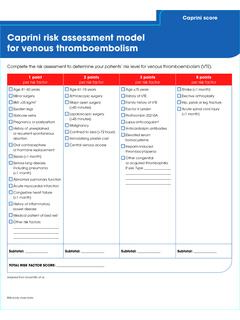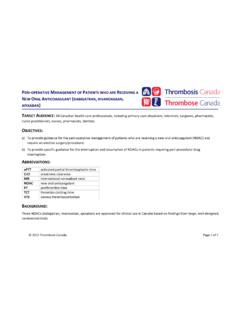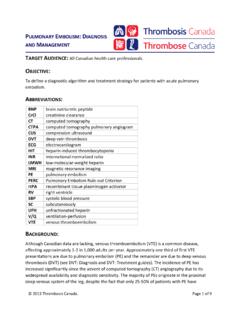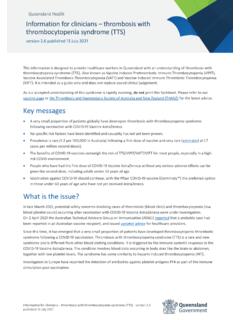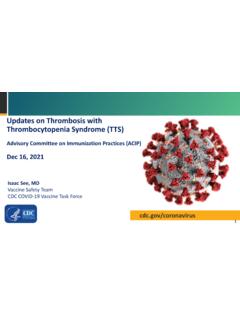Transcription of Warfarin perioperative management - Thrombosis Canada
1 2013 Thrombosis Canada . Page 1 of 8 PERI-OPERATIVE management OF PATIENTS WHO ARE RECEIVING Warfarin TARGET AUDIENCE: All Canadian health care professionals. OBJECTIVE: To provide an approach to the peri-operative management of Warfarin -treated patients and the need for bridging anticoagulation during Warfarin interruption. ABBREVIATIONS: aPTT activated partial thromboplastin time ERCP endoscopic retrograde cholangiopancreatography INR international normalized ratio IV intravenous LMWH low-molecular-weight heparin PCC prothrombin complex concentrate SC subcutaneous TIA transient ischemic attack UFH unfractionated heparin BACKGROUND: Bridging anticoagulation refers to giving a short-acting anticoagulant, typically low-molecular-weight heparin (LWMH), before and after surgery to minimize the time that patients are not anticoagulated, and, thereby, to minimize the risk for thromboembolism.
2 INDICATION: There are no strong evidence-based indications for bridging anticoagulation; bridging is suggested in high-risk patients, not suggested in low-risk patients and optional in intermediate-risk patients based on individual patient characteristics. DOSING: Bridging anticoagulation options are as follows: a) Subcutaneous (SC) therapeutic-dose LMWH: enoxaparin 1 mg/kg twice daily or mg/kg once daily; dalteparin 100 IU/kg twice daily or 200 IU/kg once daily; or tinzaparin 175 IU/kg once daily. 2013 Thrombosis Canada . Page 2 of 8 b) Intravenous (IV) unfractionated heparin (UFH) to achieve a therapeutic activated partial thromboplastin time (aPTT) defined according to local laboratory parameters. c) In patients having a high-bleeding-risk surgery/procedure, an alternate post-operative management option is SC low-dose LMWH: enoxaparin 40 mg once daily; dalteparin 5000 IU once daily; or tinzaparin 4500 IU once daily.
3 D) In patients having a very-high-bleeding-risk surgery/procedure, post-operative therapeutic-dose LMWH bridging should be avoided; alternate options are low-dose LMWH or resuming Warfarin alone. MONITORING: There is no need for laboratory monitoring of bridging with SC LMWH. Monitoring is required for bridging with IV UFH (aPTT). ADVERSE EFFECTS: Bridging is associated with a 3% risk for major bleeding and a 10-15% risk for minor bleeding. Bridging should be used carefully, as suggested in this clinical guide, to minimize this bleeding risk. PERI-PROCEDURAL management : Is peri-procedural Warfarin interruption always needed? Deciding if Warfarin interruption is needed is based on the bleeding risk of the surgery/procedure (see Table 1). Most procedures require Warfarin interruption but others ( dental, cataract surgery, minor skin) do not need Warfarin interruption.
4 Is bridging anticoagulation needed during Warfarin interruption? The need for bridging is driven largely by patients estimated risk for thromboembolism (see Table 2). What is the peri-operative anticoagulant management after Warfarin interruption? A suggested management algorithm is shown in Figure 1. When is it safe to resume bridging anticoagulation after surgery/procedure? The timing of post-procedure resumption of bridging depends on: a) the bleeding risk of the procedure (see Table 3), b) whether there is adequate post-operative hemostasis (based on wound inspection and drainage tubes to detect bleeding), and c) the class of anticoagulant used. 2013 Thrombosis Canada . Page 3 of 8 Minimizing bleeding is important because of associated morbidity; a delay in Warfarin resumption also exposes patients to an increased thromboembolic risk.
5 SPECIAL CONSIDERATIONS: Dental procedures: In patients having 1-2 dental extractions or endodontic (root canal) procedures, Warfarin can be safely continued. To reduce the incidence of gingival bleeding, patients can take oral tranexamic acid mouthwash (5 mL just before the procedure, and 2-3 times daily after the procedure until bleeding subsides). An alternative approach is to hold Warfarin for 2 days before the dental procedure. Warfarin can be resumed on the evening after the procedure. Colonoscopy & gastroscopy: Warfarin interruption will be needed for most patients who undergo colonoscopy because the potential for biopsies and/or polyp removal cannot always be determined beforehand. Caution is warranted after removal of large (> 1 cm) polyps since bleeding can occur 2-3 days after polypectomy due to dislodgement of eschar.
6 Polyp-related bleeding may be reduced with endoscopic application of clips over polyp stalk. Minor diagnostic or other procedures: Caution is warranted with anticoagulation after selected diagnostic tests ( biopsy of kidney, liver or prostate; endoscopic retrograde cholangiopancreatography [ERCP] with sphincterotomy) or minor surgeries ( pacemaker placement) which are associated with increased bleeding risk. Peri-operative management of patients receiving antiplatelet therapy: Please see the specific guides on clopidogrel, ticagrelor, prasugrel and ASA, as well as the 2012 Canadian Cardiovascular Society Guidelines on Antiplatelet Therapy, which discusses peri-operative management ( ). PEDIATRICS: Pediatricians with expertise in thromboembolism should manage, where possible, pediatric patients on Warfarin .
7 Adult guidelines are appropriate in children although holding Warfarin 3 days instead of 5 days is sufficient. Consultation with an experienced pediatric hematologist and cardiologist (as appropriate) is recommended to determine the need for bridge anticoagulation. REFERENCES: Douketis JD. perioperative management of patient who are receiving Warfarin therapy: an evidence-based and practical approach. Blood 2011;117:5044-5049. Douketis JD, Spyropoulos AC, Spencer FA, et al. perioperative management of antithrombotic therapy: Antithrombotic Therapy and Prevention of Thrombosis , 9th ed: American College of Chest Physicians Evidence-Based Clinical Practice Guidelines. Chest 2012;141(2 Suppl):e326S-350S. 2013 Thrombosis Canada . Page 4 of 8 Monagle P, Chan AK, Goldenberg NA, et al.
8 Antithrombotic therapy in neonates and children: Antithrombotic Therapy and Prevention of Thrombosis , 9th ed: American College of Chest Physicians Evidence-Based Clinical Practice Guidelines. Chest 2012;141(2 Suppl):e737S-801S. Table 1. Patient Stratification for Bleeding Risk High-Risk: neurosurgery (intracranial or spinal surgery) cardiac surgery (coronary artery bypass or heart valve replacement) major vascular surgery (abdominal aortic aneurysm repair, aortofemoral bypass) major urologic surgery (prostatectomy, bladder tumour resection) major lower limb orthopedic surgery (hip/knee joint replacement surgery) lung resection surgery intestinal anastomosis surgery permanent pacemaker insertion or internal defibrillator placement selected invasive procedures (kidney biopsy, prostate biopsy, cervical cone biopsy, pericardiocentesis, colonic polypectomy) Intermediate-Risk.
9 Other intraabdominal surgery other intrathoracic surgery other orthopedic surgery other vascular surgery Low-risk: laparoscopic cholecystectomy laparoscopic inguinal hernia repair dental procedures dermatologic procedures ophthalmologic procedures coronary angiography gastroscopy or colonoscopy selected invasive procedures (bone marrow aspirate and biopsy, lymph node biopsy, thoracentesis, paracentesis, arthrocentesis) Very Low-risk ( Warfarin interruption not needed): dental extractions (1 or 2 teeth) or teeth cleaning skin biopsy or skin cancer removal cataract removal 2013 Thrombosis Canada . Page 5 of 8 Table 2. Patient Stratification for Thromboembolism Risk High-Risk (bridging anticoagulation suggested): any mechanical prosthetic mitral valve older generation (cage-ball, tilting disc) mechanical aortic valve recent (within 3 months) arterial thromboembolism (stroke, systemic embolism, transient ischemic attack [TIA]) recent (within 3 months) venous thromboembolism (deep vein Thrombosis , pulmonary embolism) prior arterial or venous thromboembolism during interruption of Warfarin severe thrombophilia ( deficiency of protein C, protein S or antithrombin, antiphospholipid antibodies) Intermediate-Risk (bridging anticoagulation optional and based on individual patient characteristics).
10 Newer generation (bileaflet) mechanical aortic valve bioprosthetic aortic valve chronic atrial fibrillation (valvular or nonvalvular) and at least 1 major stroke risk factor: prior stroke/TIA, left ventricular dysfunction, hypertension, diabetes, or age >75 years prior venous thromboembolism within last 3-12 months Low-Risk (no bridging anticoagulation suggested): chronic atrial fibrillation (valvular or nonvalvular) and no major stroke risk factors prior venous thromboembolism over 12 months ago Consider a temporary inferior vena cava filter to be inserted aKer Warfarin interrupLon and prior to surgery for patients in whom surgery is planned within 1 month of thromboembolic episode; it can be left in situ for 1-2 weeks until therapeutic anticoagulation is re-established.


